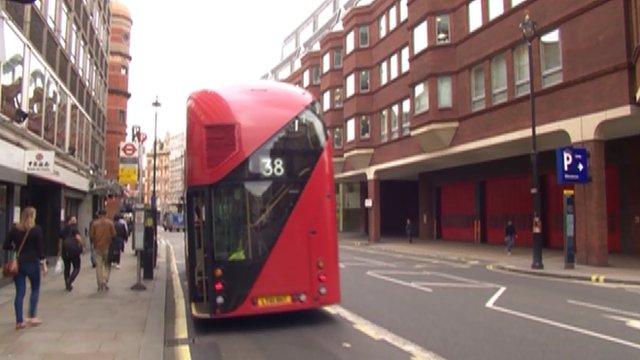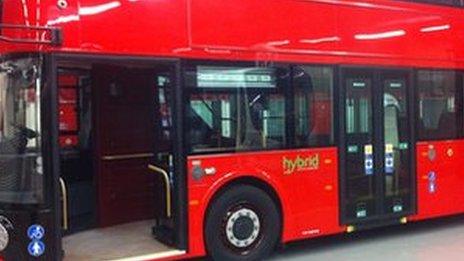Mayor hopes Treasury will hop on board travel plans
- Published
- comments
Each new bus will cost £50,000 more than the existing hybrid buses
And so the lobbying begins.
Today the mayor is in Northern Ireland showing off the new chassis production line for the 'New Bus for London', a modern design based on the old Routemaster which has prototypes running on two routes.
He's using it to show that investment in London's transport supports jobs across the UK.
Why?
Discussions are now going on between the Treasury and Transport for London (TfL) about next year's spending settlement. TfL wants sustained investment over five years of £1.8bn a year.
This is a rather odd cycle.
London jobs
Most of the time, parts of TfL boast about punctuality times improving along with customer satisfaction.
Then, as soon as the funding review rears its head, it'll happily show you some of the most outdated and crumbling infrastructure you are ever likely to see, to prove it needs more money.
The argument being made now is about the supply chain and how investment in London's transport maintains jobs.
This is a breakdown of the five biggest procurements that TfL has given me:
Bombardier - trains for sub-surface railway (Derby) £1.7bn
Invensys for track immunisation - (Chippenham) £120m
Wrightbus - new bus for London (Northern Ireland) £210m
IBM - Congestion Charging services (Coventry) £231m
Tata Steel - Rails (Scunthorpe) £35m
It also says: "Investment in London's transport network supports 40,000 jobs in the UK supply chain, with a further 19,000 supported in the supply chain within London. "
Of course not every procurement from TfL is from the UK - some of the mayor's flagship projects aren't.
The bike hire scheme comes from Canada and TfL says that cost £100m to set up.
The cable car (£45m) over the Thames comes from Austria.
The jobs argument is being made along with the infrastructure argument - that building in London creates construction jobs here.
Without £1.8bn a year, TfL says it will have to cut or mothball the Piccadilly line upgrades, new Jubilee line trains and road schemes.
That will have a direct impact on hundreds of thousands of Londoners.
City Hall also wants to make it clear transport investments aren't just about transport, they are also about how transport cash can unlock and regenerate whole areas with housing.
TfL savings
Nonetheless, efficiency savings at TfL will still be big. TfL says: "In terms of savings we have already secured £9.8bn in savings (which will be delivered by 2017/18) and we have committed to saving a further £5bn by 2021/22."
Here are some savings made so far:
£0.5bn saved from support services (HR, IT, finance) with 1,500 fewer staff
£0.5bn saved from the investment programme with better procurement, removing duplication
£0.3bn saved from rail and underground operations with 800 fewer staff
£0.4bn from the bus network including cheaper bus contracts
£0.4bn from commercial development including better use of our assets, selling buildings
It's difficult to see how that won't include job losses and with those large efficiencies there will be more emphasis on TfL to make money commercially.
That'll mean optimising advertising spaces, more office developments and station retail developments.
The view from the mayor's critics is that he paid a premium on too many schemes - like the new bus - and hasn't offered value for money.
The Lib Dems on the London Assembly point to the fact that in the mayor's 2012 transport manifesto he said the new bus would "not cost more than an existing hybrid bus".
In fact, each one will cost £50,000 more.
The big question is will that affect the view from the Treasury?
- Published10 May 2013

- Published10 May 2013

- Published27 February 2012
- Published14 September 2012